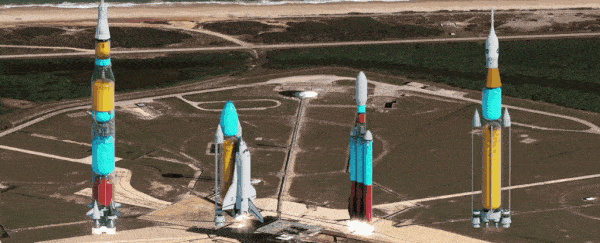I always remember hearing the comparison of how the Space Shuttle's main engines would drain an average family swimming pool in under 25 seconds. Or that the Saturn V used the equivalent of 763 elephants of fuel. But just how much fuel does a rocket burn during its ascent to orbit? As you might expect, the amount varies with different rockets.
A great new video provides an incredible visual of how much fuel is burned by four different rockets, from launch to the various stage separations by showing what rocket launches would look like if the rockets were completely transparent.
The animation from YouTuber Hazegrayart compares the four rockets, the Saturn V, the Space Shuttle, the Falcon Heavy and the Space Launch System (SLS) rockets Launching from Kennedy Space Center Launch Complex 39.

The video includes great audio of important milestones for each rocket – familiar sounds for any rocket enthusiast!
The video shows the fuel tanks being emptied as the fuel is burned to take the rockets into space. The various fuels are color coded:
Red = Kerosene RP-1
Orange = Liquid Hydrogen LH2
Blue = Liquid Oxygen LOX
How much fuel do they use? The biggest guzzler is, of course, the most powerful rocket ever launched, the Saturn V, a three-stage launch vehicle used by NASA from 1967 to 1973 for the Apollo program.
While the amount of fuel varied, depending on the mission, on average it used a total of 4,578,000 pounds (2,076,545 kg) of fuel. It could lift a payload to low Earth orbit weighing 310,000 lb (140,000 kg), and send a payload of 107,100 lb (48,600 kg) to the Moon.
The Space Shuttle, which used a combination of liquid fuel for the main engines and solid rocket boosters to lift it off the pad, used a total 3,821,722 lb (1,735,601) kg. The shuttle could lift a 65,000 payload to low Earth orbit.
The Falcon Heavy, which has launched three times, uses 90,6099 lbs (411,000 kg) of a combination of fuels and is able to lift 140,000 lbs (64,000 kilograms). Look closely at the video and you can see a tiny red Tesla Roadster on top of the payload.
The Space Launch System hasn't flown yet, but is scheduled to send the Artemis program to go back to the Moon, and potentially crewed missions to Mars.
It was hard to find how much rocket fuel it will use in total, but the 70-metric-ton- (77 ton) configuration will lift more than 154,000 pounds (69,853 kg) and will provide 10 percent more thrust than the Saturn V rocket, while the 130-metric-ton-(143 ton) configuration will lift more than 286,000 pounds (129,727 kg) and provide 20 percent more thrust than the Saturn V.
This article was originally published by Universe Today. Read the original article.
